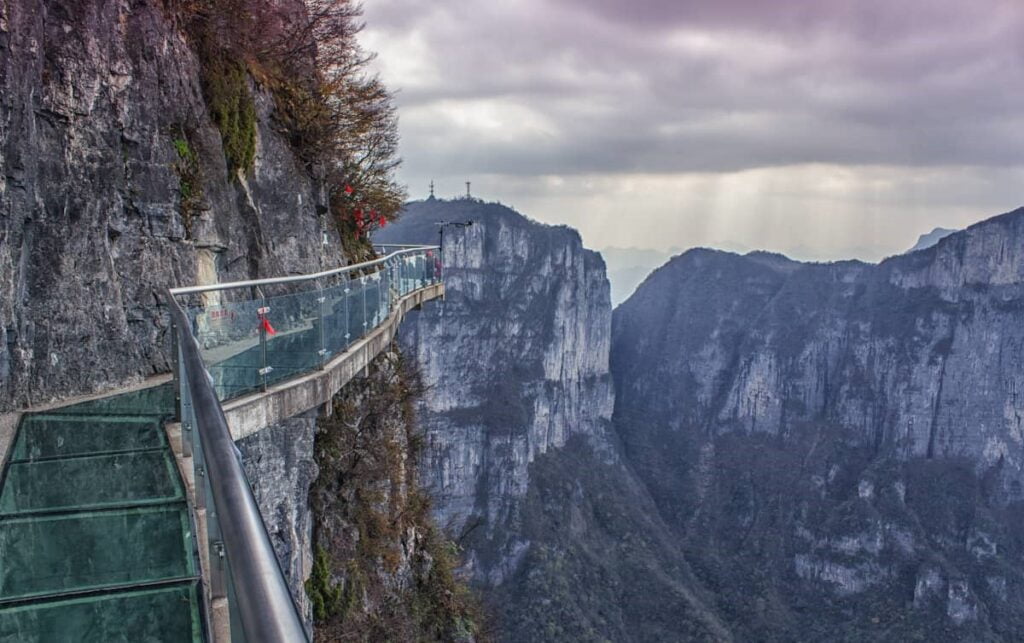If you are a fan of the blockbuster movie “AVATAR,” you might have wondered if the floating mountains were real. You would be surprised to know that they do exist, and they are called the “HALLELUJAH MOUNTAINS” or “FLOATING MOUNTAINS” in China. These mystical peaks, located in the ZHANGJIAJIE NATIONAL FOREST PARK IN CHINA, have become a major tourist attraction, drawing visitors from all over the world.

In January 2010, the 1,080-meter (3,540 ft) Southern Sky Column, a striking quartz-sandstone pillar within the park, was officially designated as “Avatar Hallelujah Mountain” (Chinese: 阿凡达-哈利路亚山; pinyin: Āfándá hālìlùyà shān) to pay homage to the film Avatar.
In this article, we will take a deep dive into the Hallelujah mountains China and explore its history, geology, and popular tourist spots.
A Brief History of the Hallelujah Mountains China
- The Discovery of the Hallelujah Mountains China: The Hallelujah Mountains China was discovered by a farmer in 1978. The farmer was exploring the forest when he stumbled upon the towering sandstone peaks that appeared to be floating in the air.
- The Name “Hallelujah Mountains China”: The name “Hallelujah Mountains China” was given to the peaks due to their resemblance to heaven, as if they were reaching towards the sky in praise.
- The UNESCO World Heritage Site: The Hallelujah Mountains China was declared a UNESCO World Heritage Site in 1992, recognizing its unique geological features and natural beauty.
6 Names of the Hallelujah Mountains
- 阿凡达山 (Āfándá shān) – This means “AVATAR MOUNTAIN” and is often used by locals and tourists to refer to the Hallelujah Mountains, in reference to the film Avatar.
- 哈利路亚山 (Hālìlùyà shān) – This means “HALLELUJAH MOUNTAIN” and is the official name given to one of the pillars within the Zhangjiajie National Forest Park, where the Hallelujah Mountains are located.
- 荒山野岭 (Huāngshān yělǐng) – This means “DESOLATE MOUNTAINS AND WILD RIDGES” and is used to describe the rugged and remote terrain of the Hallelujah Mountains.
- 神奇的山峰 (Shénqí de shānfēng) – This means “MAGICAL PEAKS” and is often used to describe the awe-inspiring beauty and uniqueness of the Hallelujah Mountains.
- 十里画廊 (Shí lǐ huàláng) – This means “TEN-MILE GALLERY” and is the name of a scenic area within the Zhangjiajie National Forest Park that features stunning views of the Hallelujah Mountains.
- 舞台天堂 (Wǔtái tiāntáng) – This means “STAGE OF HEAVEN” and is a reference to the breathtaking natural beauty of the Hallelujah Mountains, which are often described as otherworldly and almost surreal.
The Geology of the Hallelujah Mountains China
- The Formation of the Hallelujah Mountains China: The Hallelujah Mountains China was formed over millions of years through the processes of erosion, weathering, and uplift. The sandstone peaks are composed of quartz and have distinctive shapes and sizes.
- The Unique Characteristics of the Hallelujah Mountains China: The Hallelujah Mountains China is known for its vertical cliffs, deep ravines, and stunning rock formations. It is also home to a variety of flora and fauna, including rare and endangered species.
- The Biodiversity of the Hallelujah Mountains China: The Hallelujah Mountains China is home to over 3,000 species of plants and animals, including the Chinese giant salamander, which is the largest amphibian in the world.
The Hallelujah Mountains China in Pop Culture
- The Inspiration for the Floating Mountains in Avatar: The Hallelujah Mountains China was the inspiration for the floating mountains in the movie “Avatar.” Director James Cameron visited the Hallelujah Mountains China and was inspired by its beauty and grandeur.
- The Influence on Tourism in Zhangjiajie City: The popularity of the Hallelujah Mountains China has led to a surge in tourism in the nearby city of Zhangjiajie. The city has become a major tourist destination, with many visitors coming to see the Hallelujah Mountains China.
- The Cultural Significance of the Hallelujah Mountains China: The Hallelujah Mountains China is an important cultural symbol in China, representing the country’s natural beauty and spiritual beliefs. It has been featured in Chinese literature, art, and music.
The Top Tourist Attractions in the Hallelujah Mountains China
- The Zhangjiajie National Forest Park: The Zhangjiajie National Forest Park is a must-visit destination for anyone traveling to the Hallelujah Mountains China. It is home to a variety of scenic spots, including the Bailong Elevator, the Yuanjiajie Scenic Area, and the Golden Whip Stream.
- The Glass Skywalk in Tianmen Mountain: The Glass Skywalk in Tianmen Mountain is a popular attraction that offers visitors a thrilling experience of walking on a transparent glass bridge while enjoying the panoramic view of the Hallelujah Mountains China.
- The Ten-mile Natural Gallery: The Ten-mile Natural Gallery is a scenic spot in the Hallelujah Mountains China that offers visitors a picturesque view of the sandstone peaks and the lush vegetation.
- The Yellow Dragon Cave: The Yellow Dragon Cave is an underground cave system in the Hallelujah Mountains China that features stunning rock formations and natural wonders. It is a popular attraction for tourists who want to explore the geological wonders of the Hallelujah Mountains China.

How to reach and expenses
-
Transportation Costs:
- Bus: From Zhangjiajie City, you can take a bus to the entrance of Zhangjiajie National Forest Park, which is the main gateway to the Hallelujah Mountains China. The bus ticket costs around 12-15 yuan per person.
- Cable Car: There are two cable cars that take visitors up to the Hallelujah Mountains China. The Bailong Elevator, which is the highest outdoor elevator in the world, costs 72 yuan for a one-way trip and 144 yuan for a round-trip. The Tianmen Mountain Cableway costs 72 yuan for a one-way trip and 144 yuan for a round-trip.
- Private Car: If you prefer a more convenient and comfortable option, you can hire a private car or taxi to take you to the Hallelujah Mountains China. The cost varies depending on the distance and duration of the trip.
-
Entry Fees:
- Zhangjiajie National Forest Park: The entrance fee to Zhangjiajie National Forest Park is 248 yuan per person, which includes access to the park and the shuttle bus service inside the park.
- Tianmen Mountain: The entrance fee to Tianmen Mountain is 258 yuan per person, which includes access to the mountain and the cable car ride.
- Yellow Dragon Cave: The entrance fee to the Yellow Dragon Cave is 80 yuan per person.
-
Food Costs:
- There are many restaurants and food stalls inside Zhangjiajie National Forest Park and Tianmen Mountain that offer a variety of Chinese dishes and snacks. The prices range from 20-50 yuan per person for a meal.
- If you prefer to bring your own food, there are convenience stores and supermarkets in Zhangjiajie City where you can buy snacks, drinks, and other supplies.
FAQs
Q: Can you climb the Hallelujah Mountains China? A: No, climbing the Hallelujah Mountains China is strictly prohibited for safety and conservation reasons. However, there are many hiking trails and cable cars that offer spectacular views of the peaks.
Q: How do you get to the Hallelujah Mountains China? A: The nearest airport to the Hallelujah Mountains China is the Zhangjiajie Hehua Airport, which has flights to major cities in China. From there, you can take a bus or a taxi to the Zhangjiajie National Forest Park.
Q: Is the Hallelujah Mountains China open all year round? A: Yes, the Hallelujah Mountains China is open to visitors all year round. However, the best time to visit is from April to November when the weather is mild and the scenery is at its best.
Conclusion
The Hallelujah Mountains China is a breathtaking natural wonder that attracts visitors from all over the world. Visitors to the Hallelujah Mountains in China can immerse themselves in the local culture and language by learning some of these phrases and expressions, which can also help enhance their overall travel experience.







